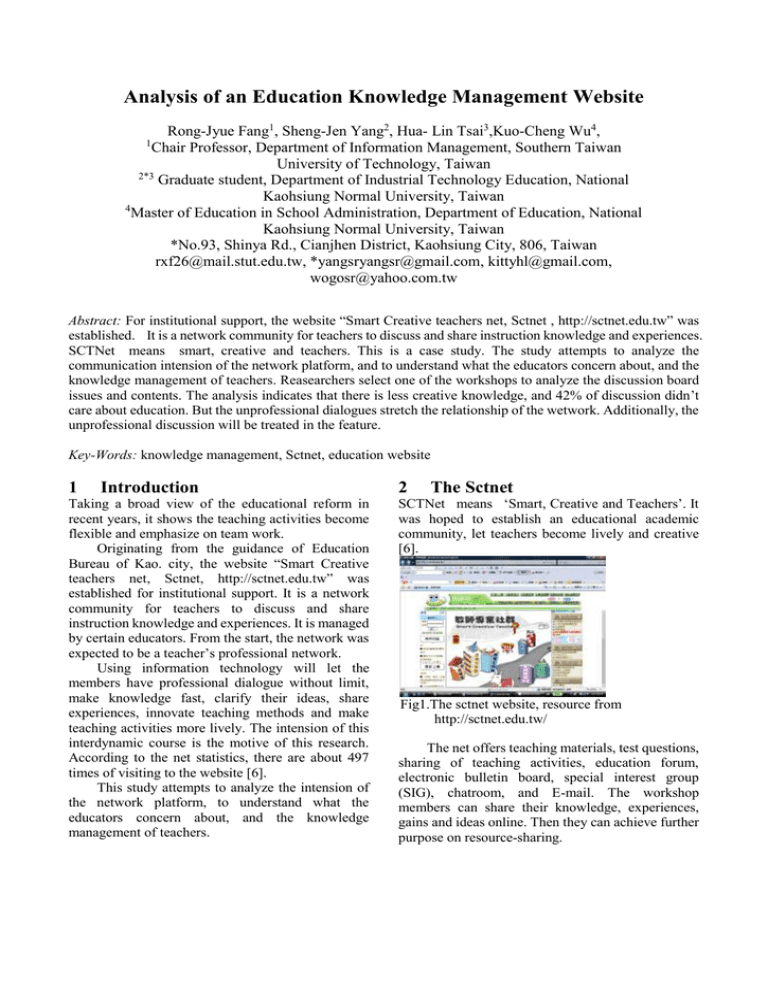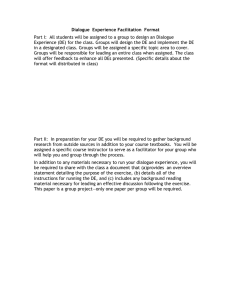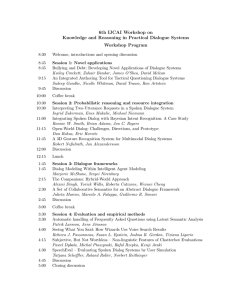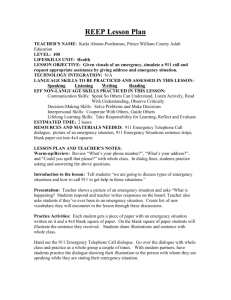Analysis of an Education Knowledge Management Website
advertisement

Analysis of an Education Knowledge Management Website Rong-Jyue Fang1, Sheng-Jen Yang2, Hua- Lin Tsai3,Kuo-Cheng Wu4, 1 Chair Professor, Department of Information Management, Southern Taiwan University of Technology, Taiwan 2*3 Graduate student, Department of Industrial Technology Education, National Kaohsiung Normal University, Taiwan 4 Master of Education in School Administration, Department of Education, National Kaohsiung Normal University, Taiwan *No.93, Shinya Rd., Cianjhen District, Kaohsiung City, 806, Taiwan rxf26@mail.stut.edu.tw, *yangsryangsr@gmail.com, kittyhl@gmail.com, wogosr@yahoo.com.tw Abstract: For institutional support, the website “Smart Creative teachers net, Sctnet , http://sctnet.edu.tw” was established. It is a network community for teachers to discuss and share instruction knowledge and experiences. SCTNet means smart, creative and teachers. This is a case study. The study attempts to analyze the communication intension of the network platform, and to understand what the educators concern about, and the knowledge management of teachers. Reasearchers select one of the workshops to analyze the discussion board issues and contents. The analysis indicates that there is less creative knowledge, and 42% of discussion didn’t care about education. But the unprofessional dialogues stretch the relationship of the wetwork. Additionally, the unprofessional discussion will be treated in the feature. Key-Words: knowledge management, Sctnet, education website 1 Introduction Taking a broad view of the educational reform in recent years, it shows the teaching activities become flexible and emphasize on team work. Originating from the guidance of Education Bureau of Kao. city, the website “Smart Creative teachers net, Sctnet, http://sctnet.edu.tw” was established for institutional support. It is a network community for teachers to discuss and share instruction knowledge and experiences. It is managed by certain educators. From the start, the network was expected to be a teacher’s professional network. Using information technology will let the members have professional dialogue without limit, make knowledge fast, clarify their ideas, share experiences, innovate teaching methods and make teaching activities more lively. The intension of this interdynamic course is the motive of this research. According to the net statistics, there are about 497 times of visiting to the website [6]. This study attempts to analyze the intension of the network platform, to understand what the educators concern about, and the knowledge management of teachers. 2 The Sctnet SCTNet means ‘Smart, Creative and Teachers’. It was hoped to establish an educational academic community, let teachers become lively and creative [6]. Fig1.The sctnet website, resource from http://sctnet.edu.tw/ The net offers teaching materials, test questions, sharing of teaching activities, education forum, electronic bulletin board, special interest group (SIG), chatroom, and E-mail. The workshop members can share their knowledge, experiences, gains and ideas online. Then they can achieve further purpose on resource-sharing. Fig3. The function of workshop Fig2. The structure of Sctnet getting from http://sctnet.edu.tw,2008,01,20. SCTNet is a virtual organization, and its main purpose is to help teachers share their professional knowledge and experience mutually, then to set up a teacher's professional social network, and to promote the sharing of teaching experences across schools and districts. The potention of such organization will be unlimited if it combines the various teachers’ specialities. Sctnet is divided into 10 major parts including 1865 workshops which offer interactive discussion for teachers with interest in different fields. The function in the workshops includes school community, interest field, classmate, teaching application, education training, study support, administration coordinate, ect. However, the workshops with function of teaching skills are concerned the best. Among them, the purpose of some workshops is to transmit administrative matters or manage administrative communication. The members of those workshops are mainly administrative persons from schools. For example, the workshops are named : Administrative sky of school, secret base of general affairs, practice workshop of consistent course in nine years, the consistent administrative work workshop, health workshop etc. All administrative matters can be put on discussion board or the message board for members’ discussion. In addition, members can receive relative messages through their E-mail. The function of the workshop offers resources-sharing, discussion board and message board. Discussion board provides members to create issues for discussing, and list all didcussion contets on-line. All members can see every issue here. We can understand how the teachers are interested in different issues and their response to them. 3 3.1 Literature Review Knowledge Management is a Trend Knowledge management is about using the brain power of a systematic and organized organization to achieve efficiencies, ensure competitive advantages, and spur innovations[17]. The tacit knowledge possessed by individuals is crucial and instrumental to an organization’s operation and survival. However, reaching the point which employees willingly share what they know is tough. But IT has made it relatively easy to organize, post, and transfer certain types of information[17].In other words, knowledge sharing is more important in the process of knowledge management. The application in education of knowledge management has been a trend that can’t be ignored. Professional dialogue is an important type for knowledge management. The combination of information science and technology can gather various communications from the platform into a database. The database is a base for receiving, understanding, storing, and innovating educational knowledge. 3.2 Knowledge Management Process Knowledge management is a complex process that must be supported by a strong foundation of enablers. The enablers for KM are strategy and leadership, culture, measurement, and technology. Each of these must be designed and managed in alignment with others in support of the process. The process usually involves several following stages or subprocesses in the use of knowledge: receiving, identifying, application and creation[5]. 3.2.1 Knowledge Receiving For example, knowledge can be received from five ways: merchandise, the relationship with other companies, study cooperation, institutes of educational training and the flow of members. Moreover, while the receiving of knowledge is organized, the obtaining of its goal should be paid attention. The interaction between different sources and information must be managed properly. 3.2.2 Knowledge Identify The research about knowledge identify management is focused on the precise, degree deepening and understanding of knowledge inside the organization, and discusses on diversity of knowledge. Such as traditional manufacturing industry, service trade and Hi-Tech industry, there is much difference between the knowledge models they own and use. Thus, effective confirmation on knowledge is the main step to precise and deepen the knowledge in organization. Educators should have the ability to identify the professional knowledge. So the degree of the contents of professional dialogues to knowledge identify is one of the intension to be analyzed in this study, it’s also the process to confirm if the workshop reaches the target of knowledge management. 3.2.3 Knowledge Application The focal point of knowledge application managing the orientation of knowledge application is here emphatically: achieving the goal of sharing with the real example is through which ways and course knowledge is. Dynamic view should organize knowledge from social knowledge and external knowledge, combine knowledge to flow to four procedures of inside knowledge, then reach the diffusion of knowledge, and finish the sharing of knowledge. In addition, tacit knowledge and outside show the transformation between knowledge and diffusion relation inside are the courses that these two kinds of research orientations pay attention. Purpose and workshop lie in knowledge of workshop person share, how be workshop person in latent knowledge inside that workplace produce, transform into outside where the workshop can be shared and show knowledge, impel other members to apply to the job market of the job, and get the result of real example. 3.2.4 Knowledge Innovation Knowledge innovation management focuses on the value after application. For example, to manage and use the knowledge and experience of an organization systematically can add appropriate practice for action value. Whether workshop members look for, understand, and use knowledge with the systematized method, and then create the education value, it is also an intention to be researched and analyzed. 4 Study Method There are 672 issues and 13233 dialogue contents for analysing. Before data analyzed, the team pre-analyzed for several times, and discussed the regularities. Two researchers participated the analysis, the other two members did double check. Discussion issue Fig4. Discussion board Each dialog shows here Fig 5. Contents of dialog The main shafts of analysis are knowledge receiving, knowledge identify, knowledge application and knowledge innovation.The times and percentage of those shafts are counted by different learning fields, see figure6. The meanings of differnet numbers are: 0 :means inprofessional dialog 1 : means knowledge obtained 2 : means knowledge Identify 3 : means knowledge Application 4 : means knowledge create Fig 6. Science field dialog definition chart 5 Findings and Discussion 5.1 Findings (1)According to the percentage chart, we found that the unprofessional dialog was 42.46%, knowledge recieving was 21%, knowledge identify 22%, knowledge application 13% and knowledge Innovation 1%. But for knowledge innovation, there is not much difference among different fields. For knowledge receiving, life and science fields takes higer percentage, and mathematics field takes the lowest percentage; for knowledge identify, mathematics is the highest; for knowledge application, Chinese is the highest and activities is the lowest,; for knowledge innovation, activities is the highest and life field is the lowest. 5.2 Discussion Fig7. Percentage of dialog (2) Difference appears in the percentage of knowledge management from the dialogue of different learning fields. Table 1. Knowledge management dialog in leaning field inprofessional knowledge receiving knowledge knowledge idntify application knowledge create language 30.36% 10.40% 27.24% 31.33% 0.58% math 44.66% 7% 41.44% 4.97% 1.93% social 54.96% 21.28% 11.16% 11.57% 1.03% science 50.20% 38.09% 6.43% 4.94% 0.34% life 26.50% 43.55% 19.35% 10.37% 0.23% art 47.83% 26.45% 19.77% 5.47% 0.48% heath & physical 40.21% 28.52% 24.74% 5.84% 0.69% activity 55.46% 13.38% 24.96% 3.75% 2.45% Dialogue of knowledge management in learning fields It concentrates mainly on Chinese, mathematics, nature, science and technology field of life. However, there are no relevant proportions in the dialogue content and knowledge management. There is a phenomenon on the high side except life field. So, there are different levels on constructing knowledge. The dialogue content on the discussion board of this workshop takes 43% about the interaction of knowledge receiving and identify. The dialogue has performed the elementary benefit of knowledge management on network platform. Dialogue of this level provides the basic information and opportunity of identifying for related knowledge constructer for various curriculum. Higher level about application and innovation 14% only. Besides, administrative transmitting, emotional communication, and interactive encouragement take 42.6%. Nothing to do with knowledge constructing, members here interact with each other a lot. The dialogue not related to knowledge constructing has great influence and is necessary to the running of this workshop. Because that is the value of using the network platform to talk freely. 6 Conclusion The workshop provides instant communication on different fields for members, and identifies the knowledge received through on-line discussion. Identifying knowledge is the basis of knowledge application. The results members get from the curriculum workshop (question, talk, react) can confirm and identify the knowledge sources, also improve the curriculum development and teaching quality by applying knowledge. For knowledge management, the hardest goal to be reached is knowledge innovation. It means to use knowledge to create action and value. The dialogue about human concern promotes the interaction, which is the value of using the network platform to take freely and the attraction to promote members’ interaction. The promotion of higher interactive website about administrative matters is another way worthy of being considered by E-government. References: [1]Alley, Lee R.. Diverting a Crisis in Global Human and Economic Development: a New Transitional Model for Lifelong Continuous Learning and Personal Knowledge Management. Higher Education in Europe, Vol. 24 Issue 2, Jul99, pp187-195. [2]B. Berelson(1952). Content Analysis in Communication Research .Glencoe: Free press, pp.18. [3]Chang E. Koh, Sherry Ryan, Victor R. Prybutok, Creating Value Through Managing Knoeledge in an E-Government to Constituency, Journal of Computer Information System, Summer 2005, pp. 32-41. [4]Chun-Chieh Liao, A Field Study in the Externalising of Tacit Knowledge in On-the-Job Training , International Journal of Management Vol. 22 No. 1, March 2005, 79-88. [5]http://www.apqc.org/,2008,01,20. [6]http://sctnet edu.tw, 2008,01,28. [7]Kinney, Thomas. Knowledge Management, Intellectual Capital and Adult Learning. Adult Learning, Winter98/99, Vol. 10 Issue 2, pp2-4. [8]Koenig, Michael E.D.. Education for knowledge management. Information Services & Use, Vol. 19 Issue 1, 1999, pp 17-31. [9]Leonard-Barton, D.and Walter Swap, When Sparks Fly-Igniting creating in group ,Harvard business School Press, 1999. [10]Malhotra, Y. “What Is the Big Idea? Knowledge and Its Future.” The Executive Report on Knowledge, Technology and Performance. Knowledge Inc., The Millennium Issue, January 2000. [11]Nonaka, Ikujiro& Hirotaka Takeuchi(1995),The knowledge creating company. New York: oxford university Press. [12]North, D., Institutions ,Institutional Change and Economic Performance ,Cambridge University Press, 1990. [13]Polianyi, M., The Tacit Dimension ,New York : M. E. Sharp Inc, 1967. [14]Quinn,J.B., Managing Professional Intellect : Making the Most of the best ,Harvard business School press, 1996. [15]Pertovic, Otto; Kailer, Norbert; Scheff, Josef; Vogel, Doug.Learning aspects of knowledge management and new technologies. Journal of European Industrial Training, Vol. 22 Issue 6/7, 1998, pp277-288. [16]Raisinghani, Mahesh S.. Knowledge management: A cognitive perspective on business and education. American Business Review, Vol. 18 Issue 2, Jun2000, pp. 105-120. [17]Serban, Andreea M.; Jing Luan. Overview of Knowledge Management, New Directions for Institutional Research, Vol. 2002, Issue 113, Spring2002, p5-16.



